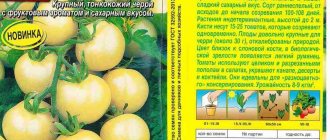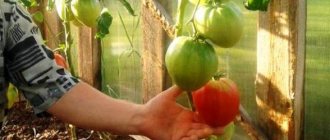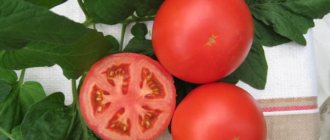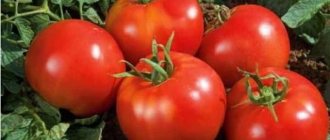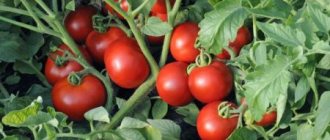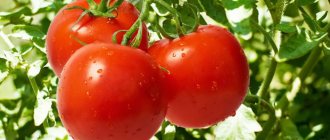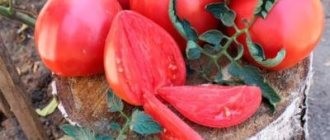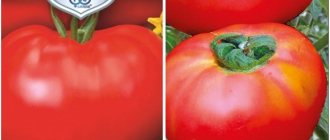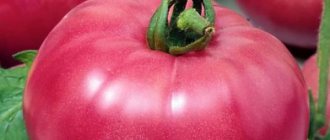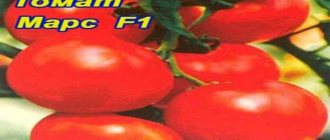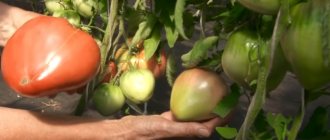Tomatoes are most susceptible to it, but it can also affect many other crops. The disease completely destroys the plantings, depriving them of the harvest. Plants suffer especially often in greenhouse conditions, where constant humidity and heat contribute to the development and spread of the disease. But how to protect seedlings from death and damage? There are several ways:
- disinfect seeds and soil before planting;
- disinfect the greenhouse itself;
- treat plants during their growth;
- choose tomato varieties for the greenhouse that are resistant to late blight.
The last method is an excellent alternative to the previous three. After all, no matter how hard you try, do not treat the seedlings and the greenhouse, there is still a possibility of infection. In addition, the disease can come from a neighboring greenhouse. And if the tomatoes are resistant, then the problem will disappear by itself. So, below we will list what kind of varieties these are that are not afraid of even the most nasty ailment. But first, information for those who do not know what late blight is.
Characteristics and description of the variety
The Vesna hybrid was created in the Altai Territory, a region with a sharply continental climate, where even in summer the temperature difference per day can be 25 degrees. The result of the work of local breeders is an indeterminate variety of tomatoes for greenhouses, high-yielding and with a short ripening period (vegetation period - 90-100 days).
Characteristics and description of the Spring tomato variety:
- medium-sized bushes, 40-60 cm tall;
- The trunk of the plants is strong, but staking is necessary;
- shoot formation is weak, foliage is average;
- leaves are large, dark green in color;
- the plant forms 5-6 fruit clusters with 4-6 fruits in each.
According to the experience of gardeners, with the correct agricultural technology, the Vesna tomato can be successfully cultivated in open beds.
Fruit
Tomatoes are round in shape, slightly ribbed near the stem. Ripe fruits acquire a rich red color (the shape of the fruit and color are clearly visible in the photo). At the stage of technical ripeness, they are light green, with a darker spot at the base.
They are approximately the same in weight - 170-220 g. The skin is smooth, resistant to cracking. The pulp is fleshy and juicy. Inside the berry there are 4 chambers with a small number of seeds. Can be removed from bushes at the stage of technical maturity for ripening at home.
Externally, the hybrid is similar to such early-ripening tomatoes as Blagovest F1, Impala F1, Lyubasha F1.
Taste qualities
The fruits exhibit their best taste when fresh - it is rich, sweetish with a slight sourness. The pulp is juicy, but not watery.
Productivity
One of the important advantages of the hybrid is its high yield, which does not depend on weather conditions.
To date, the maximum harvest per square meter of planting area has been recorded - 17 kg. On average, 6-7 kg of tomato fruits are harvested from a bush in greenhouse conditions with proper agricultural technology (timely application of fertilizers and regular watering).
Usage
Vesna tomato fruits are universal in use: they can be preserved and processed in any way. Canned and soaked, they do not crack or get wet. They can be transported over long distances without deformation or spoilage, and therefore producers of these early vitamin products usually sell their harvest at a profit.
Tomato "Werner" F1 in Moscow
Tomato “Werner” F1 and other products in this category are available in the catalog of the Leroy Merlin online store in Moscow at low prices. Check out the detailed characteristics of this product, which will help you make the right choice and order the product online. If necessary, our specialists in retail stores will provide you with detailed advice.
Buy products such as Tomato “Werner” F1 in the online store or Leroy Merlin hypermarket, having first checked their availability.
READ MORE: Delicious tomato variety description, yield with photos
You can always place an order and pay for it online on the official website of Leroy Merlin in Russia. For residents of the Moscow region, we not only have low prices for goods such as Tomato Werner F1, but also fast delivery to cities such as Moscow, Balashikha, Podolsk, Khimki, Korolev, Mytishchi, Lyubertsy, Krasnogorsk, Elektrostal, Kolomna, Odintsovo, Domodedovo, Serpukhov, Shchelkovo, Orekhovo-Zuevo, Ramenskoye, Dolgoprudny, Pushkino, Reutov, Sergiev Posad, Voskresensk, Lobnya, Klin, Ivanteevka, Dubna, Yegoryevsk, Chekhov, Dmitrov, Vidnoye, Stupino, Pavlovsky Posad, Nar- Fominsk, Fryazino, Lytkarino, Dzerzhinsky and Solnechnogorsk.
Growing seedlings
Seed material for preparing seedlings must be purchased anew each time, since hybrids do not reproduce parental characteristics - plants grown from independently collected Vesna tomato seeds do not inherit the excellent qualities of the variety.
Planting seeds
Sowing seeds for seedlings is carried out 60-65 days before the intended transfer of seedlings to a permanent place - in
greenhouse or open beds. For central Russia, this is approximately the first half or mid-March.
For those who use the lunar sowing calendar in planting work, the optimal time for planting seems to be when the star is still growing, but is already close to the Full Moon. Before planting, Spring F1 tomato seeds are disinfected with a slightly pink solution of potassium permanganate for half an hour and dried. You can additionally treat them with any of the growth stimulants.
In a moistened soil mixture - taken in equal proportions of turf soil, peat and coarse river sand - holes are made 1.5-2 cm deep, the seeds are laid out and sprinkled with soil without compacting.
At first, keep seedling boxes with tomato seedlings in a room with a temperature of 22-25 ° C under a film, thus creating mini-greenhouse conditions for the seeds. They try to “stretch” the daylight hours to 10-12 hours using artificial lighting.
Watering
Water the sown tomato seeds immediately and then make sure that the soil is constantly moistened, but not flooded with water. Use settled, warm water (1-2 degrees above room temperature). In order not to wash away the seeds in the soil, it is convenient to moisten it with a spray bottle.
Once every ten days, liquid mineral fertilizer is added to the water for irrigation.
Picking
To make the root system of seedlings more powerful, seedlings dive after 2-3 leaves appear. Transplanted into separate containers according to the following scheme:
- a couple of hours before the procedure, the sprouts are watered with warm water;
- separate containers are filled with a slightly damp earthen mixture, making depressions in it (the entire length of the root of the transplanted plant);
- the seedling, using any convenient device (teaspoon, knitting needle, pencil, etc.), is carefully removed from the soil and its root is cleared of excess soil;
- to stimulate the growth of lateral roots, pinch the central root a couple of millimeters;
- placed in the hole almost up to the cotyledon leaves, sprinkled with earth and pressed down a little with your fingers.
After picking, the tomato seedlings are sprayed and kept away from direct sunlight for several days.
Agricultural technology of the hybrid Spring of the North
In Russia, the hybrid is grown in seedlings, sowing seeds for seedlings approximately two months before planting them in the ground or greenhouse. Agricultural technology involves the following measures, which are described step by step below.
Determining and preparing a place for beds.
Tomatoes are heat-loving plants, so the place for growing them should be well-lit, ventilated, and the soil on the site should be light and rich in nutrients. An essential criterion for selection is what crops were grown last season. It’s good if it’s cucumbers or cabbage, beans or peas, soybeans, carrots, beets, rapeseed, green manure herbs. It is very undesirable to plant tomatoes for the second year in a row in one place or after potatoes, eggplant, and peppers. It is also important to plan your neighbors in advance, because two different varieties of tomatoes will pollinate each other and spoil their beneficial qualities.
The main fertilization of the site should be carried out in the fall, since over the winter the applied organic matter and mineral fertilizers will be absorbed into the soil and will be suitable for feeding the plant throughout the season. So, among organic fertilizers, cow manure and bird droppings are suitable for these purposes. Green fertilizer will be herbs or root crops sown at the end of summer, which are plowed with the soil.
Mineral fertilizers include superphosphates, potassium nitrate, and nitrophoska. Application rates to the soil range from 25 to 50 g of each fertilizer per square meter. They can be used both in combination with organic matter and separately from it.
Landing in the ground
Young Spring tomatoes are transferred to a permanent place of growth when 6-7 leaves and one inflorescence appear on them. The beds are pre-fertilized with ordinary humus or a complex mineral mixture.
In order for the seedlings to quickly adapt to new conditions, they are hardened in advance:
- a week before planting, in the morning and evening, tomato sprouts are left for several hours at a cooler than usual temperature - taken out to a cold veranda or balcony, in warm spring weather - outside;
- gradually the “hardening” time is lengthened - tomatoes can spend the night at a temperature of 7-11 °C.
3-4 plants are placed per square meter (in ordinary beds, holes 30 cm deep are spaced 50-60 cm apart). After planting, the tomato bushes are carefully watered and mulched with sawdust or straw.
If the crop is planted in open space, it is advisable that the area is well lit and protected from northern winds.
Pests and diseases
Successful cultivation of tomatoes is only possible when using healthy soil and a well-ventilated area. Excessive soil and air moisture can cause late blight. And premature yellowing and curling of the leaves of the bush may indicate a lack of copper in the nutrients supplied.
Necessary regular ventilation and reduction of excessive air humidity concerns the appearance of whiteflies. For preventive plant protection, garlic or milk solution can be used per 10 liters of water. In the first case, you need about 250 g of crushed garlic, and in the second, a liter of whey will do.
When using fungicides, it is extremely important not to apply more than two weeks before the first harvest. Excessive dryness of the soil and air in the greenhouse can provoke the appearance of spider mites. One of the main ways to combat diseases is to create growing conditions. This applies to air temperature, frequency of watering and regularity of room ventilation.
It wouldn’t hurt to place garlic or onion peels in the hole with seedlings. This should repel germs and fungal infections from the plant itself.
Features of care
Growing tomatoes in Spring requires compliance with the usual agrotechnical practices:
- bushes are formed into 2-3 stems, taking stepson once every ten days (since the shoot-forming ability of the hybrid is weak, the stepsons grow slightly);
- water in hot weather once every 2-3 days, if it’s cloudy - a little less often, at the root;
- In open beds, timely weeding and removal of weeds are important.
Fertilize the plants in the standard way for tomatoes:
- 20 days after transferring the seedlings to a permanent place of growth - nitrophoska;
- 10 days after the first feeding - potassium sulfate;
- after another 10-12 days - superphosphate and wood ash.
Organic matter is also gratefully received by tomatoes - it is added a little every couple of weeks.
What to do after sprouts appear?
Tomato Werner f1, like other varieties, should be watered abundantly only after the first leaves appear. And the already strong sprouts can be planted in the soil closer to mid-June.
During planting, it is better to do pruning, that is, slightly trim the roots of the plant to improve their growth.
A distance of half a meter should be left between seedlings so that the root systems of neighboring bushes do not interfere with each other.
The sprouts should be carefully looked after for a week after planting so that they become stronger. Apart from the time after planting in open ground, the shoots are not afraid of the sun, cold and wind. Dutch producers made sure that with minimal care this variety produces a rich harvest. And as experience has proven, Werner tomatoes are successfully grown in the far north of Russia.
So, let's repeat the action plan:
- plant seeds in a pot;
- when sprouts appear, we take the pots out onto the balcony;
- We begin abundant watering after the leaves appear;
- we plant the strengthened sprouts in the soil;
- we take care for a week after planting;
- We are waiting for the result.
Advantages and disadvantages of the variety
The advantages of the domestic hybrid tomato selection Spring are many, which is the basis of its popularity among gardeners, especially those who grow tomatoes for sale:
- high yield regardless of weather conditions;
- good immunity to major tomato diseases;
- low shoot formation, which reduces the time and effort spent on pinching;
- good quality of fruits, sufficient for transportation over long distances without loss of presentation;
- high taste qualities;
- ability to ripen without loss when removed at the stage of milk ripeness.
The only disadvantage is the need to completely replenish the supply of seeds every year, since hybrid forms do not reproduce varietal characteristics.
The Spring F1 tomato is a real gift for gardeners: a hybrid that is resistant to difficult weather conditions will bring a bountiful early harvest with a minimum of effort and resources.
Description of the hybrid
Eijen f1 is a product of Enza Zaden (Netherlands). It was included in the State Register of Russia in 2012. Suitable for growing in film-type greenhouses with or without heating.
Mid-early hybrid. The bushes are indeterminate and require staking. The harvest is harvested in spring and summer.
In the photo - tomatoes Eijen f1.
Distinctive features
The table summarizes the main characteristics of the hybrid.
| Indicators | Characteristic |
| Weight | 150–220 g |
| Form | Flat-round, medium ribbed |
| Coloring | Red |
| Leaves | Medium size, green |
| Type of inflorescences | Simple |
| Number of slots | Six or more |
| Pulp | Medium density, juicy, not watery |
| Taste | Sweet and sour |
| Skin | Dense |
| Purpose | Universal |
| Bush height | 1.5–1.8 m |
| Ripening period | 85–100 days from sowing |
| Productivity | 8.3–10.8 kg/m² |
| Sustainability | To verticillium, fusarium, cladosporiosis, tobacco mosaic virus (TMV) |
| Transportability | High |
